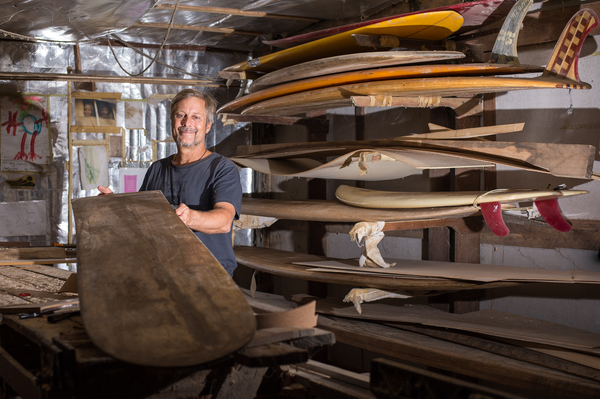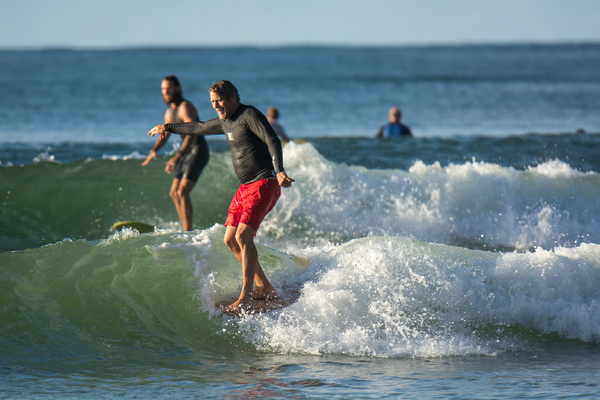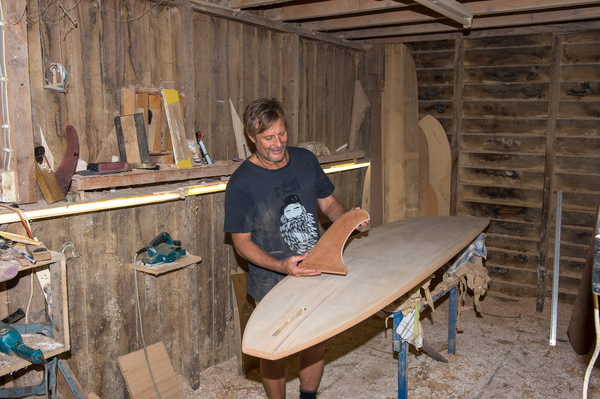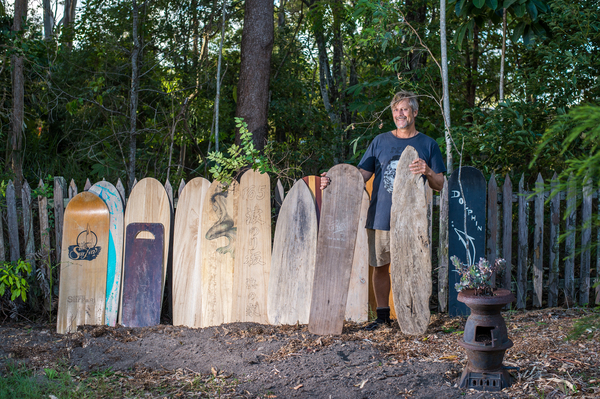When we think of board shapers, we often think of them as a little reclusive, keeping their skills close to their chests perhaps, but salt-of-the-earth shaper Tom Wegener is all about sharing; sharing the knowledge, sharing the excitement, sharing the waves and sharing the future of the board industry.
Shaping boards in his loft at Cooroy for over a decade, Tom’s stoke for surfing and shaping is certainly not waning. If anything, the grin so synonymous with Wegener is growing bigger.
Tom is always breaking new ground. His palpable passion for the sport and his boyish enthusiasm has resulted in forward thinking projects which continue to take surfing to the next level.
First it was introducing finless surfing to the masses with his Alaia boards, next being the catalyst to finless becoming a part of the World Surfing League and now once again, Tom is on the cusp of a new surfing revolution with his use of cork.
After visiting the ancient surfboards in Hawaii’s Bishop Museum, his board shaping took an unexpected turn.
“I realised the amazing amount of craftsmanship that had gone into their finless wooden boards. I came home and began to make them out of Paulownia. This is a wood which doesn’t absorb salt water, which is still such a baffling concept to me,” Tom said.
“Finding Paulownia meant that I was able to make boards just as the ancient Hawaiians did without all the problems they had trying to keep the water out of them. When I started making these there was not one finless surfboard in the world,” he said.
These ‘Alaia’ boards became popular across the globe and before long, elders from Papua New Guinea contacted Tom about coming to help them with their traditional wooden boards.
“The elders were concerned that the locals don’t surf wooden surfboards anymore. They just want foam surfboards they said and that there are a hundred kids and only a few boards to share. The traditional craft of making their wooden boards was disappearing.
“They asked me to go and teach them how to update their wooden surfboards and I came across an enormous amount of balsa wood over there. We started making the boards out of the balsa and teaching them how to make them, so after three years or so, the locals were making really nice wood boards on their own.”
The locals still had some questions about the validity of the wooden boards and were still heavily influenced to use the new style fibreglass boards. When the World Surfing League decided to take the contest to Papua New Guinea it was an opportunity for the locals to see the pros surfing the wooden boards convincingly.
From this came two incredible wins, a wooden board division became a part of the WSL contest and the locals saw wooden boards in a whole new light.
“They didn’t have to rely on the foam boards donated to them over the years anymore. Seeing what could be done with the wooden boards inspired them. They realised that they could actually make these boards themselves, just like Papua New Guineans have done for centuries,”
Tom’s approach to evolving surfing is about making it accessible to everyone. Not to simply sell boards himself, but to teach others how to make a living this way, keep traditions alive and to experiment.
“I wanted to show them (Papua New Guineans) that this is how you can make a living off surfboards. You can actually make these boards and sell them yourselves now,” Tom said.
Pro surfers were using them in Waimea Bay and with the help of friend Jacob Stuth, the Alaia revolution was well underway. They were salt water resistant and finless but there was room for improvement; they needed more flexibility and float.
Tom creates boards from absolute scratch. His shaping shack is a bit like Tom himself, not at all pretentious – humble and a little weathered but brimming with new projects, full of character and stories. There’s a lot of love in this space and you get the feeling that anything is possible here. Tom’s down to earth, joyful energy is in every room and he is passing it on to the next generation of shapers.
Alongside Tom’s quest to improve the Alaia came his desire to learn and teach more. In discovering the use of cork in his boards, he began teaching locals how to make their own boards in the hope of keeping shaping alive.
“I hope with the new process we are developing we can teach classes because I want to get people back into making surfboards again,” he said.
“It’s very exciting because I have discovered the use of foam to give flex. By using foam in the middle, wood on the bottom and cork on the deck, the cork smashes into itself. When you glue the cork to the foam it never buckles and creases like a fibreglass board does. The flex is incredible on these boards.”
The boards are soft in the rails and the wood underneath is very fast. Tom pushes on the two ends of this board while I wince in anticipation of snap. If this thing was fibreglass, it would have creased for sure, but instead it flexes perfectly and bounces back into shape.
“It’s not waterproof, the cork, but I’ve learned if you have a layer of glass over foam, the water goes in and can’t get out again but if you have a porous covering the water just comes out again. It can dry,” he said.
“With this type of flex, you can do great bottom turns. Through this process, we can start over again. We can do anything we want! It’s very exciting,” he grins.
“Bringing in the cork has meant I can shape my finless surfboards with the right flex, get the right amount of float and they’re green.
“I want to share this with people. I’m so excited to teach people how to make their own and how they do this chemical free in their own home and expand their own designs.
Tom gives massive accolades to his wife, Margie for being the catalyst for bringing teaching on a more permanent basis to the forefront of his career.
“Margie really is instrumental in this. She has been so important to changing our business model to incorporate teaching. I’m pretty hapless at production. two or three boards a week is about all I can do, but teaching people is what I really enjoy. Within the year, my space will be expanded to become a quality space to teach people this craft.”
The bonus of this invaluable opportunity to learn the art form is that when other surfboard factories have toxic chemicals and a huge amount of disposable waste, Tom’s factory has no toxic materials and creates almost no waste, earning him the Sunshine Coast Living Smart Glossie award for his factory in 2012. Learning to shape with Tom is about the whole big picture, so watch this space for his future shaping classes.
When he’s lured away from the foam by way of waves, Tom’s love for the ocean is contagious. You can’t help but get the stoke when you see the boyish grin on Tom’s face after a good surf and it reminds you what surfing is all about. Whether it’s on a bellyboard, a finless or a longboard, it’s all about good times.
“It’s so much fun. Every different board, you are wearing a different hat. The wave is the same, but the board means your approach is so different.
“I am definitely at the extreme end of the surfing relationship spectrum – impulsive, have to surf all the time, always wanting to learn more.”
For the board shaping industry, Tom’s extreme relationship with surfing has meant that the next generation can continue to craft boards by hand and push the norm. He has become an intrinsic contributor to surfing’s evolution and plans to teach all he knows to anyone who wants to learn, that is unless the swell comes up.










